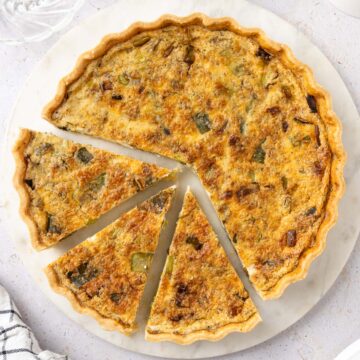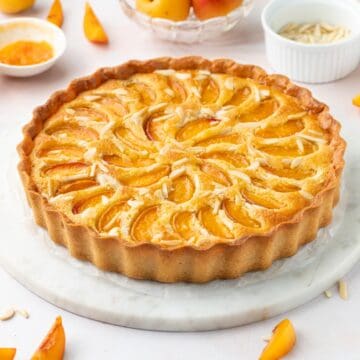These Lemon Curd Tartlets are a delicious and fancy little dessert to serve at a party or for afternoon tea. Buttery, crunchy and oh so tangy, these Mini Lemon Tarts combine a homemade shortcrust pastry and creamy lemon curd into a delicious bite!
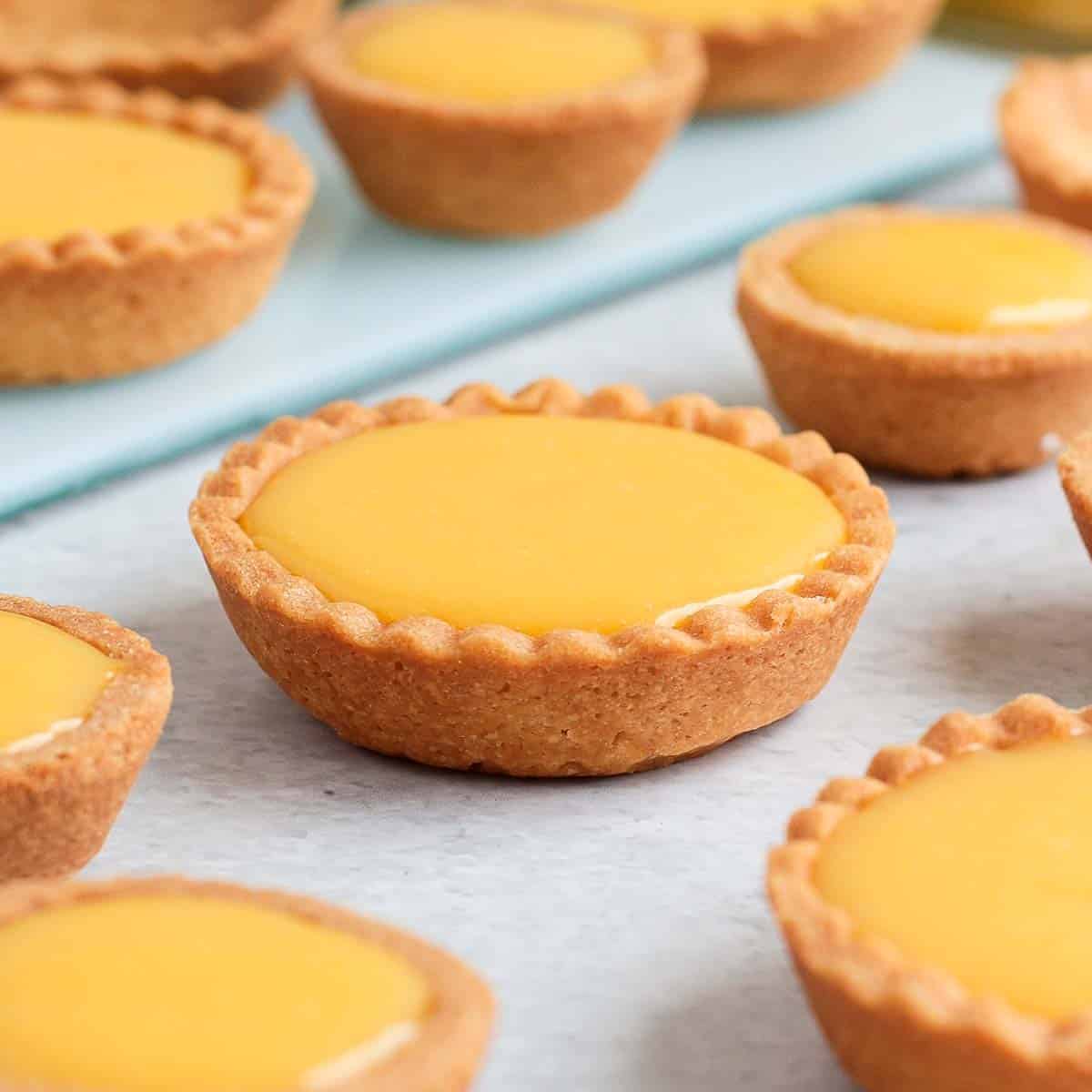
Jump to:
Why we love this recipe
Who doesn't love a good, tangy Lemon Tart? This classic French dessert is one of those recipes that everyone is always so happy to eat. These Lemon Curd Tartlets are perfect if you are looking for a bite-size party dessert. They are also great for the Holidays and for afternoon tea!
These Mini Lemon Tarts simply combine some homemade Mini Tartlet Shells made with a Pâte Sablée (French Shortcrust Pastry) and some Lemon Curd. Just like my Mini Lemon Cheesecakes, they are packed with tangy lemon flavours.
It is a fairly easy recipe to prepare. Both the pastry and the curd can be made in advance and assembled on the day, which is always so handy. You can enjoy them as is, finish with a Meringue to make Mini Lemon Meringue Tarts or make a larger Lemon Cud Tart version. These tartlets are a go-to recipe for all parties, Holidays and gatherings!
Ingredients

You will only need a few basic ingredients to make these super easy Mini Lemon Tarts.
For the Shortcrust Pastry (scroll down for all quantities):
- Dry Ingredients: a combination of Plain/AP Flour, Salt and Icing Sugar (or Powdered Sugar)
- Wet Ingredients: some very cold Unsalted Butter and a medium-sized Egg (at room temperature).
You could also add the zest of a lemon into the pastry if you wanted to boost the lemon flavour even more!
For the Lemon Curd (scroll down for all quantities):
- Eggs: the Yolks only. They need to be at room temperature.
- Lemon: both the Juice and the Zest. You could use some bottled lemon juice if you don't have fresh fruits, but lemon curd tends to taste better with fresh lemon.
- Sugar: simple Caster / Fine Granulated White Sugar.
- Butter: Unsalted and at room temperature. It is important that the butter is not too cold or the curd might split when you add it to the pot.

How to make Mini Lemon Curd Tarts
This Mini Lemon Tarts with Shortbread Crust recipe is made in two steps, just like my Orange Tartlets: preparing the tartlet pastry then making the lemon curd.
Making the Shortcrust Pastry
I usually use my Food Processor to make Pastry but it can absolutely be made by hands as well. You can see how to make these by hands in my Pâte Sablée recipe.
- Photo 1: combine the Flour, Icing Sugar and Salt in the bowl of your food processor and pulse to combine. Add the very cold Butter cut into small cubes.
- Photo 2: pulse until you get very small crumbs. You don't want large lumps of butter in this pastry recipe because it would result in a flakier pastry.
- Photo 3: Add the Egg (I like to whisk it in a separate bowl first so that it blends in better with the rest of the ingredients).
- Photo 4: slowly pulse until a dough starts to come together (try not to over-blend the pastry). If you press the crumbs in your hands, they should stick together.
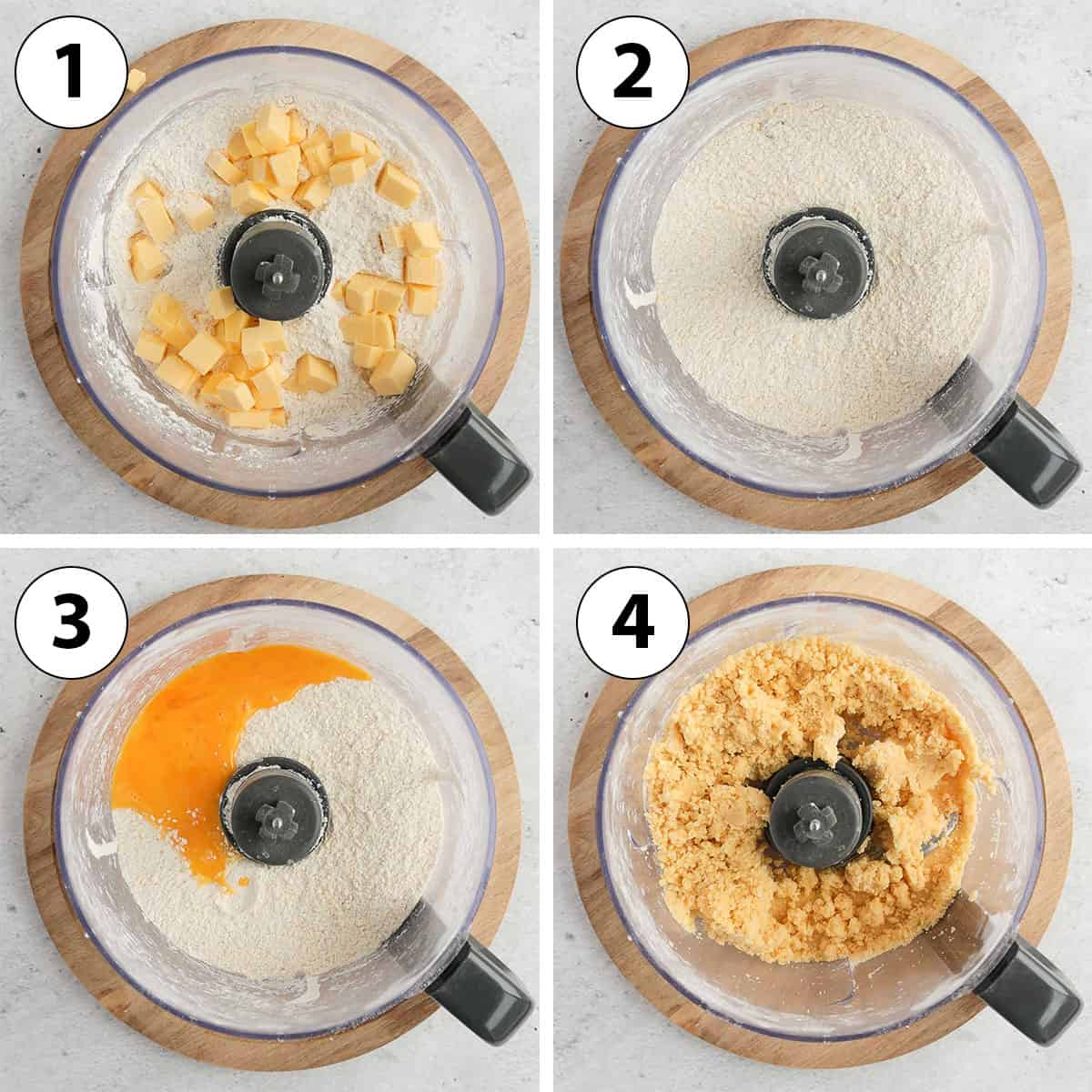
Making the Tartlet shells the Muffin Pan
- Assemble the dough into a ball then roll between two sheets of baking paper. The pastry should be about 3 mm or 1/8 inch thick. Place over a flat tray and leave in the fridge to rest and chill for at least an hour, or up to 24 hours.
- Photo 5: Using a round or fluted Cookie Cutter, cut out small rounds of pastry. The larger the disk of pastry, the deeper the tartlets will be. They should be at least the same width as the opening of the muffin pan holes.
I used a regular Muffin Pan for this recipe, but you could also use a Mini muffin Pan to create some mini lemon tart bites.
- Photo 6: Gently slide each pastry into the muffin pan. Run a finger on the bottom and around the edges of the pan to remove any air-bubbles.
- Photo 7: Prick the bottom of the pastries with a fork then place back in the fridge for at leat 1 hour or up to 24 hours.
- Preheat your oven on 160'C/325'F and place the pan in the freezer while it is preheating.
- Photo 8: Line the pastries with small pieces of baking paper and fill with baking beads, beans or rice. Bake for 15 minutes, then remove the weights and baking paper. Place back in the oven for another 15 minutes or until fully baked.
- Leave to cool down completely.
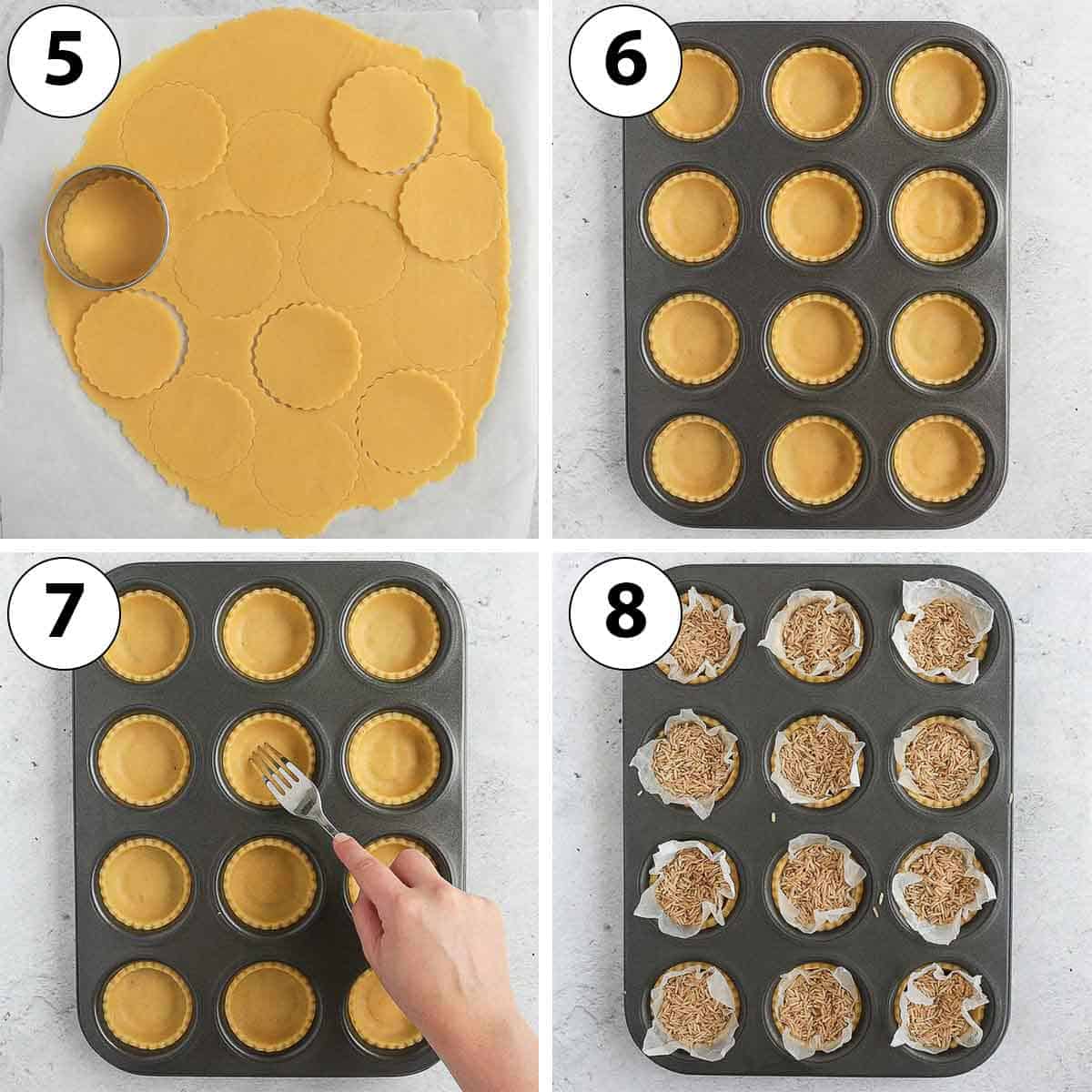
Preparing the Lemon Curd
- Photo 9: In a small Pot, combine the Lemon Juice, Egg Yolks and Sugar. Whisk to combine then turn on low heat. Whisk for about 5 minutes, or until the liquid starts to slightly thicken.
- Photo 10: add the cubed Butter a little bit at the time, whisking until fully melted and combined before adding more. If you add all the butter at once (or if it is too cold), the curd might split.
- Photo 11: add the Lemon Zest then cook on very low heat whilst continuously whisking for 5 to 15 minutes, or until the curd has thickened.
- Photo 12: to check that the curd is ready, dip the back of a spoon in the curd and draw a line into the curd with your finger. Tip the spoon down and see if any of the curd is dripping down over the line. If the line stays clear, the curd is cooked. You can also check with a thermometer - the curd is cooked when it reaches about 82'C/180'F.
Directly pour the hot curd into the Tartlet Shells. Gently tap each mini lemon curd tarts over a hard surface to remove any air bubbles, then place in the fridge to set for at least 2 to 3 hours.
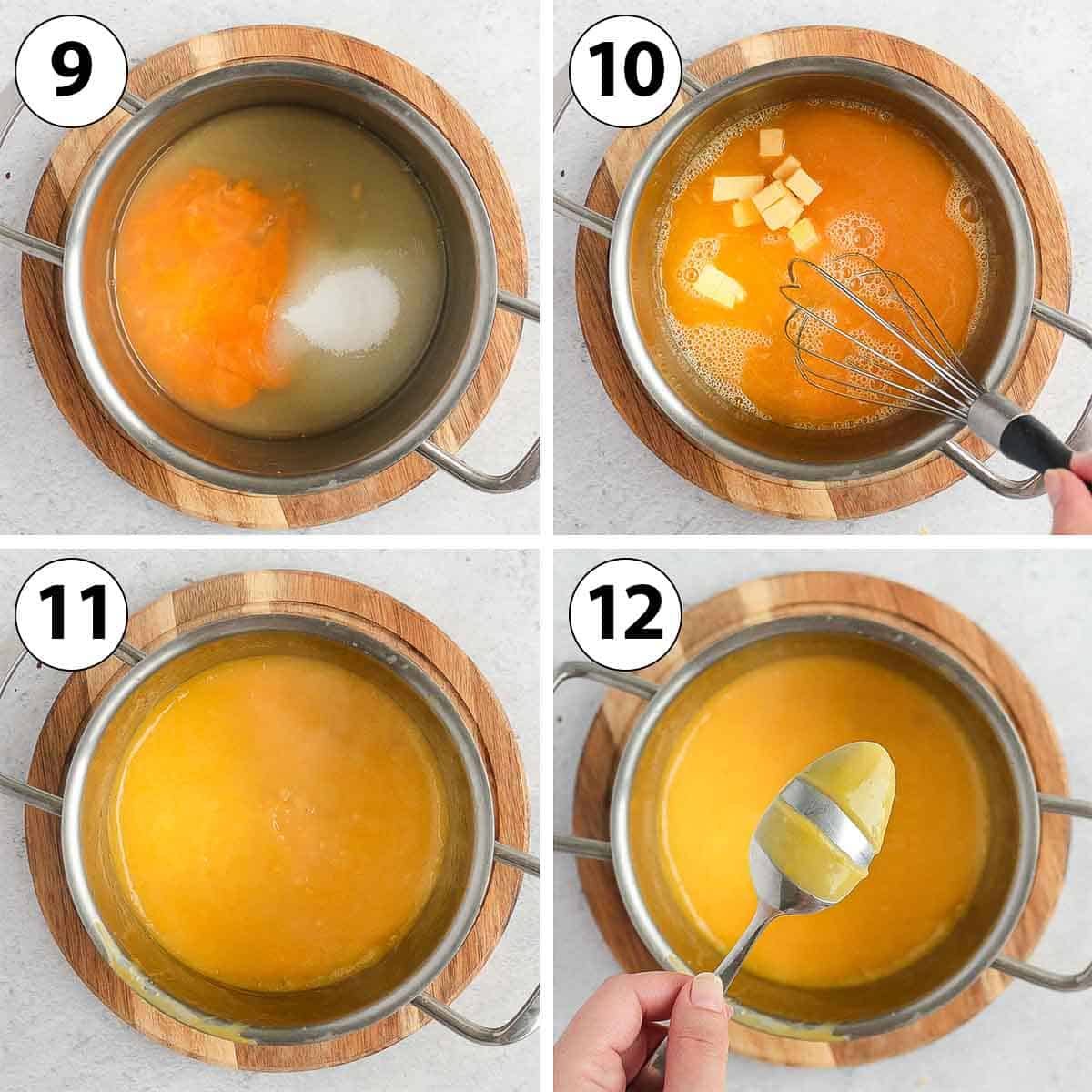
Tips to make this Recipe
- Always cook a Curd on very low heat to avoid over-cooking the eggs or burning the curd. It will take longer to cook, but the lemon curd will be very smooth and without any lumps.
- Allow for the lemon curd tartlets to spend at least 2 to 3 hours in the fridge so that the curd can set. Otherwise, the curd will be very liquid and ooze out of the shells when you bite into it.
- Both the Tartlet Shells and the Curd can be made in advance and combined a few hours before serving. Keep the tartlet shells at room temperature for 2 days and the lemon curd in the fridge for 3 days. Slightly heat up the curd to loosen it before filling the tart crusts on the day, and place back in the fridge to set for at least 2 to 3 hours.
- Replace the Lemon with Meyer Lemons, Orange, Lime or any of your favourite Citrus to try different flavours!
- Use a Mini Muffin Pan instead of a Regular Muffin Pan to create a bite-size dessert! I recommend rolling the pastry thinner if using a mini muffin pan.
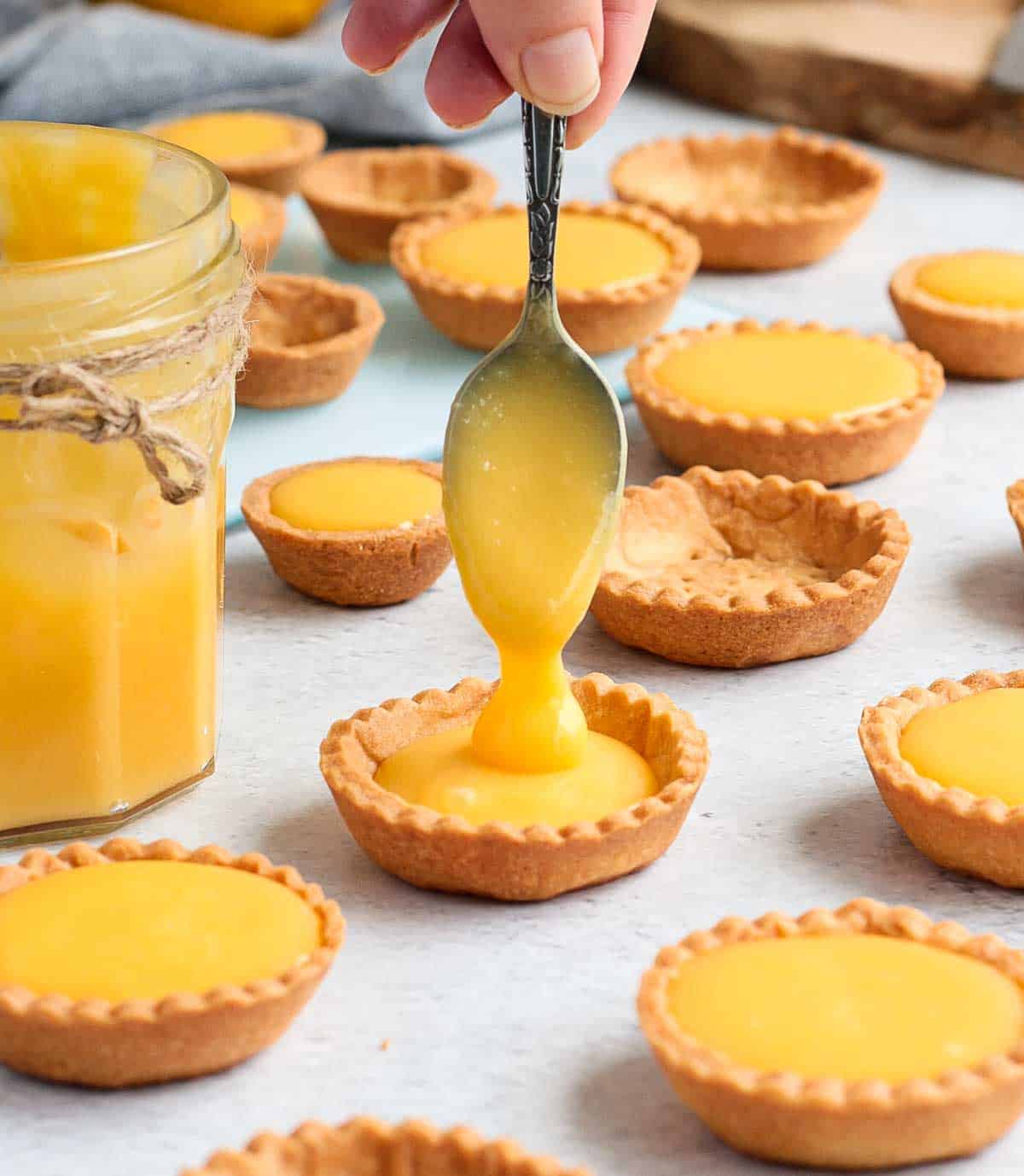
Recipe FAQs
Yes, you can use store-bought Tartlet Shells to make these Lemon Butter Tarts, although I always recommend making your own pastry for flavour.
You can absolutely make these Lemon Tarts using a jar of Lemon Curd from the supermarket. I personally prefer to make my own Lemon Curd so that I can adjust the level of sweetness/tanginess to my liking.
Both the pastries and the curd can be made in advance and assembled a few hours before serving. The baked crusts can be kept at room temperature for 2 days, and the curd can be kept in the fridge for up to 3 days.
Simply fill the tart crusts with the curd 2 to 3 hours before you want to serve them and keep them in the fridge to set until then.
Storing & Freezing
As explained above, the unfilled crusts can be kept at room temperature for up to 2 days and the curd in the fridge for 3 days. Once assembled, the lemon curd tartlets should be kept in the fridge and will stay crispy for 2 days.
The tartlet Crusts can be frozen, either raw or baked, but I do not recommend freezing the filled tarts or the lemon curd.

Made this recipe?
Let us know if you liked it by leaving a comment below, and tag us on Instagram @a.baking.journey with a photo of your creation!
Recipe
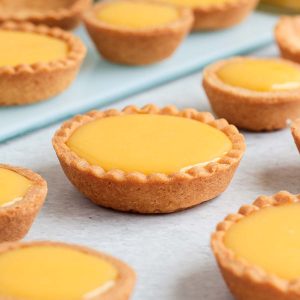
Lemon Curd Tartlets
Ingredients
Tartlet Shells
- 250 gr All-Purpose / Plain Flour
- 50 gr Icing Sugar - sifted
- 1 pinch Fine Salt
- 120 gr Unsalted Butter - cold
- 1 large Egg - at room temperature
Lemon Curd
- 4 Egg Yolks
- 100 gr Caster Sugar - or fine white granulated sugar
- 125 ml Lemon Juice - about 3 large lemons
- 75 gr Unsalted Butter - at room temperature
- 1 Lemon Zest - optional
Disclaimer
I highly recommend using the measurements in grams & ml (instead of cups & spoons) for more accuracy and better results.
Instructions
Tartlet Shells
- Place the Flour, Icing Sugar and Salt in the bowl of your Food Processor and pulse to mix (see note 1 if making by hands). Add the cold Butter cut into small cubes, then mix to get very small crumbs.
- Whisk the egg in a separate bowl and add it to the food processor. Slowly pusle until a dough starts to come together (see note 2).
- Bring the dough together into a ball and roll between two sheets of baking paper to be about 4 mm or 1/6 inch thick. Place on a flat tray and leave in the fridge to chill and rest for at least 1 hour, or up to 24 hours.
- Remove the baking paper. With a round or fluted cookie cutter that is about 1,5 to 2 cm (0.6 to 0.8 inch) wider than the opening of the muffin pan, cut out disks of pastry (see note 3). Gently slide the disks of pastry into a muffin pan and lightly press on the bottom corners to make sure the pastry is touching the pan all around - and to remove any air bubbles that could be trapped under the pastry. Pro tip: use a muffin pan with perforated bottom to insure an even air flow and optimal baking with minimal shrinkage.
- Place back in the fridge to rest and chill for at least 2 hour - preferably overnight.
- Preheat your oven on 160'C/325'F. Prick the bottom of the pastries with a fork and place the muffin pan in the freezer while the oven is preheating.
- Line each tartlet shells with a small piece of crunched up baking paper and fill with baking beads, rice or beans. Bake for 15 minutes, then remove the weights and baking paper and bake for another 15 minutes, or until golden and dry to the touch. Set aside to cool down completely.
Lemon Curd
- Place the Egg Yolks, Sugar and Lemon Juice in a small pot. Whisk to combine then turn on very low to low heat. Whisk for a few minutes or until the liquid looks like it is starting to thicken - about 3 to 5 minutes.
- Cut the butter into small cubes and slowly add them to the pot. Whisk until melted and combined each time before adding more. Add the Lemon Zest
- Cook on low heat for 5 to 15 minutes or until the curd has thickened. Continuously whisk to avoid lumps (see note 4).
- To check if the curd is cooked, dip the back of a spoon into the curd then draw a line in the curd with your fingers (be careful, it will be hot). Tip the spoon down and check if any of the curd is dripping down over the clear line. If the line stays clear, the curd is ready. If the curd pours over the line, it needs to cook for longer.
Assembling the Lemon Tarts
- While still warm, pour the curd into the tartlet shells. Gently tap each tartlet against a hard surface to remove any air bubbles, then place in the fridge to set for at least 2 to 3 hours (see note 5).
Tried this recipe? Make sure to leave a comment and star rating below!
Notes
- If you don't have a food processor, you can make the pastry by hands or using a pastry blender. You can find the detailed step by step instructions on how to make the dough by hands here.
- Avoid overworking the pastry by stopping as soon as part of the pastry comes together. To know it is mixed enough, press some lumps of pastry between your hand. If they should stick together, the pastry is ready. If too dry, add a little bit of very cold water. If very sticky, add a little bit more flour.
- The wider you cut out the circles of pastry, the deeper the tartlet shells will be. It is up to you how wide you cut them out, but I recommend having the width of the muffin pan openings as a minimum. Otherwise, the crusts will be quite flat and not deep enough for a filling.
- The time it will take for the curd to be cooked will depend on the heat of your stove. You should always cook a curd on very low heat to avoid burning it or getting lumps.
- You could also make the lemon curd in advance (up to 3 days in advance) and slightly reheat it up to fill the tartlets on the day you need them. Either reheat on a double-boiler, or for a few seconds in the microwave (but be careful not to reheat for to long or you might cook it).


